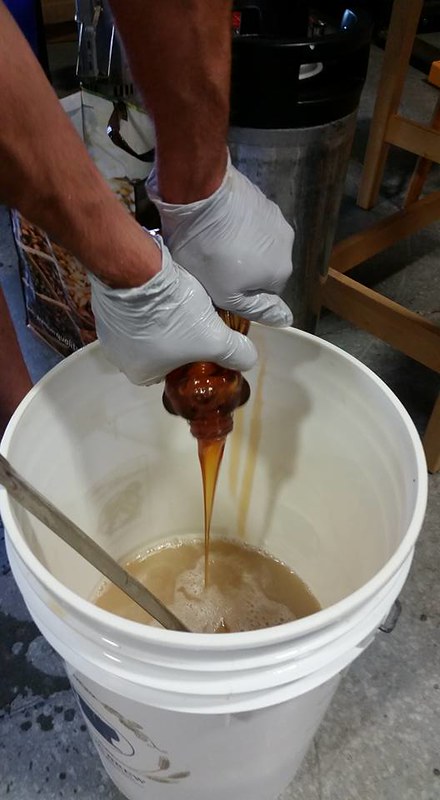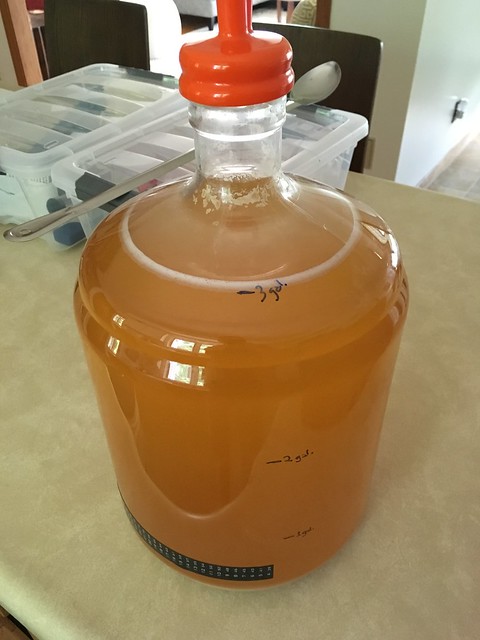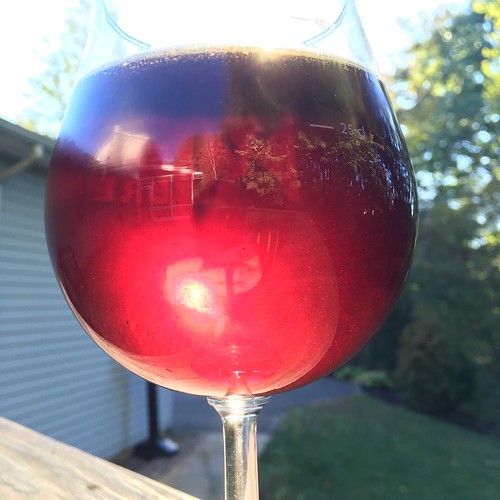Homebrew #40: Imposter Syndrome (The Mead Day Mead)
¶ by Rob FrieselFiled under: How do I get myself into these things? It started when the local homebrew club reached out to me for help setting up an event for AHA’s Mead Day. The general idea was to do a club event that talked a bit about mead, demonstrated mead making, and then a little Q&A. It sounded like another club member was going to do the demo. But then that club member had to back out. I guess as the 2017 Vermont Mead Maker of the Year, it was my duty (!?!?) to step up and see that the event went on. Maybe everyone missed the memo where I’d only (personally) made mead one time. Which maybe explains why I went on to call this particular batch Imposter Syndrome.
When it became clear to me that the burden honor of making the batch of Mead Day mead would fall to me, I had to hastily put together a formulation. A 3 gallon batch seemed a reasonable size. I’d originally thought to use 3 lb. of the blackberry blossom honey that I’d used for Diplomatic Mission, but the local homebrew supply store was out of that. They were also out of my second choice orange blossom honey. Fortunately (third time’s the charm!) they had a raspberry blossom honey that would fit the bill nicely. But 3 lb. of honey in a 3 gal. batch is… quite the hydromel. So I “cheated” and threw another pound-and-a-half of the household happy bear honey from CostCo.
Brew Day
The Groennfell and Havoc meaderies were gracious enough to host our event on that Saturday afternoon. I rolled up with my ingredients and my pre-sanitized gear and my Corny full of pre-heated water and… fussed and fidgeted over a pint of Bitter Bee while we waited for our start time.
When you get right down to it, you can make a serviceable mead 1 with very few steps and very little effort. 2 With that in mind, for my vanishingly small audience, I performed the following magic trick:
- I dissolved 3 Campden tablets into about two gallons of water.
- I added some yeast nutrient and stirred that into solution.
- I mixed up honey (with vigorous stirring!) into that water until it was in solution, turning it into must.
- I transferred the must into a carboy.
- I topped off the carboy.
- I took that carboy home, waited 24 hours, and pitched my yeast.
An O.G. of 1.056. There really wasn’t anything more complicated than that.
Fermentation
After the Campden tablets had finished doing their thing, I pitched my yeast. I’d originally thought to pitch two packets of EC-1118. But after I’d gotten home from the homebrew supply, I noticed that I picked up one sachet of EC-1118 and one of D-47. Then again, I also had a sachet of Belle Saison, which is what I’d used for Diplomatic Mission.
Decisions, decisions…
Ultimately, I pitched the single sachet of Belle Saison (can’t argue with winners!) and called it a day. I’d save the D-47 for another batch; I’d save the EC-1118 in case the Belle Saison stalled. I walked away. I let the yeast do their thing.
Six days after pitching, the gravity was at 1.002. Another six days and it was at 0.998. BeerSmith seemed to think it might come down as far as 0.988, but four days later it was still sitting tight at 0.998. I called that the final gravity and moved ahead with packaging. But what to do? Prime for a sparkling mead? Package it as still? See about making a dry hopped or spiced batch?
I thought back to the day at the meadery, and a conversation I’d had with Jason (the homebrew club president). He’d talked about how, with the right base beer mead, you could really turn it into multiple finished products. He talked about taking a saison and dividing it up several different ways: a portion as a classic saison, another aged on wood, another conditioned on fruit, another on spice…
And so that’s what I did here.
I racked 64 oz. into a carboy and onto some rose hips. Rhodomel, here we come.
I filled 6 × 22 oz. bottles with the mead as-is. A still, dry short mead.
And with what remained… I primed it with honey and bottled it in a bunch of flip-tops.
And the little bit left-over from the bottling bucket? Pretty great, actually.
Overall Impressions
While I have been training my senses for beer judging, and while many of those techniques and skills are transferrable, I haven’t put the same effort into learning about my meads. Most of my mead judging is filed under the rubric of “I know what I like”. That being said, I’ll give a structured sensory evaluation just the same.
AROMA. Mild but discernible honey character throughout. There’s a faint ester suggestive of pear, and something else hinting at white pepper. (Belle Saison, I’m looking in your direction.) These are slightly more pronounced in the sparkling bottles.
APPEARANCE. A pale yellow. Excellent clarity. Sparkling bottles have a slight haze where the lees get disturbed, and have a parade of fine bubbles that gather in a delicate lace around surface.
FLAVOR. Dry, with a soft honey character. It gets faintly fruity mid-palate (and retronasally) — suggesting pear and ripe berries. Mild alcohol character, with that slight warming that enhances the crispness of the dry finish. Background sulphur notes retronasally as it warms up, so maybe a fermentation fault there — but luckily this is quite faint. Sparkling bottles feel brighter on the tongue from the carbonation — likely more acidic by a small degree.
MOUTHFEEL. Light body and smooth sensations. Sparkling bottles are effervescent.
Overall? Not bad for something I slapped together at the last minute. I suspect that some of my beer brewing skills have turned out to be transferrable? I would say “not bad for a first time” but… that braggot says otherwise. I would like to experiment a bit more with different varietals, different honey treatments (e.g., a bochet), and some different yeast strains (e.g., how would this be different with D-47?) But that’s more about exploring the mead space, and less about this specific formulation.
UPDATE: (10/1/2017) Getting back to that rhodomel experiment…
Deep rich color. Super dark red in the light, otherwise a royal purple. Aromas are low overall, but impart a sweet-tart impression. The flavor is a mix of cherry and currant, with floral notes coming retronasally. The mouthfeel is rich and velvety. I’d primed this bottle, which brought no head, but provided a gentle carbonation. I might have overdone the rose hips a bit but… satisfied overall. More than satisfied, actually. I wish I’d made twice as much.
Recipe
The recipe for Imposter Syndrome is as follows:
Water Chemistry
Starting with the Champlain Water District profile as a base, add 1 Campden tablet per gallon.
Fermentables
- 3 lb. raspberry blossom honey
- 1½ lb. clover honey
Yeast
1 sachet Lallemand Belle Saison
Brew Day
- Collect 12 qt. water and heat to 105°F. Pour 2 gallons into a mixing vessel (e.g., PET bucket); add 3 Campden tablets and 2 oz. of yeast nutrient. Stir until dissolved.
- Add 3 lb. raspberry blossom honey and 1½ lb. clover honey to water. Stir until dissolved. Now you have must.
- Let sit 24 hours for Campden tablets to finish working.
- Aerate the must; pitch Belle Saison yeast.
- Start fermentation at 70°F.
Beyond Brew Day
- Allow fermentation to complete (approx. 2 weeks) at approx. 72-78°F.
- When fermentation completes, go ahead and package. Maybe cellar some to see how they age. Otherwise…
- Enjoy!
Details
Imposter Syndrome, a dry short mead by Tilde Gravitywerks
| Original Gravity | 1.056 |
| Final Gravity | 0.998 |
| ABV | 7.6% |
| Attenuation | 103.8% |
| SRM | 2 |
| Links | Flickr Facebook event |
- I say “serviceable” because, as my Mead Day demo asserted, just about any honey + water + yeast combination will ferment and produce a mead that you could drink and share without feeling shame. But I also say “serviceable” because I don’t want to imply that there is nothing else to it. Technique and ingredient selection can (and will) go a long way toward producing a higher quality product. But by all means, use the happy bear honey for your quick meads.[↩]
- The very important caveat to “few steps and little effort” being that you definitely don’t want to skip over the cleaning and sanitation. Star San makes it trivial to keep the bugs off your gear. Be liberal with it.[↩]
About Rob Friesel
Software engineer by day. Science fiction writer by night. Weekend homebrewer, beer educator at Black Flannel, and Certified Cicerone. Author of The PhantomJS Cookbook and a short story in Please Do Not Remove. View all posts by Rob Friesel →9 Responses to Homebrew #40: Imposter Syndrome (The Mead Day Mead)
Pingback: Homebrew #43: Syntactic Sugar (The Vermont Code Camp Mead) | found drama
Pingback: Homebrew #45: Evil Clone | found drama
Pingback: 2017 Wrap-Up | found drama
Pingback: 2018 Greg Noonan Memorial Homebrew Competition Results | found drama
Pingback: Homebrew #69: A Mead Has No Name (2018 Mead Day Mead) | found drama
Pingback: Homebrew #90: Ned | found drama








Leave a Reply